Special Report
Countries Doing the Most and Least to Protect the Environment
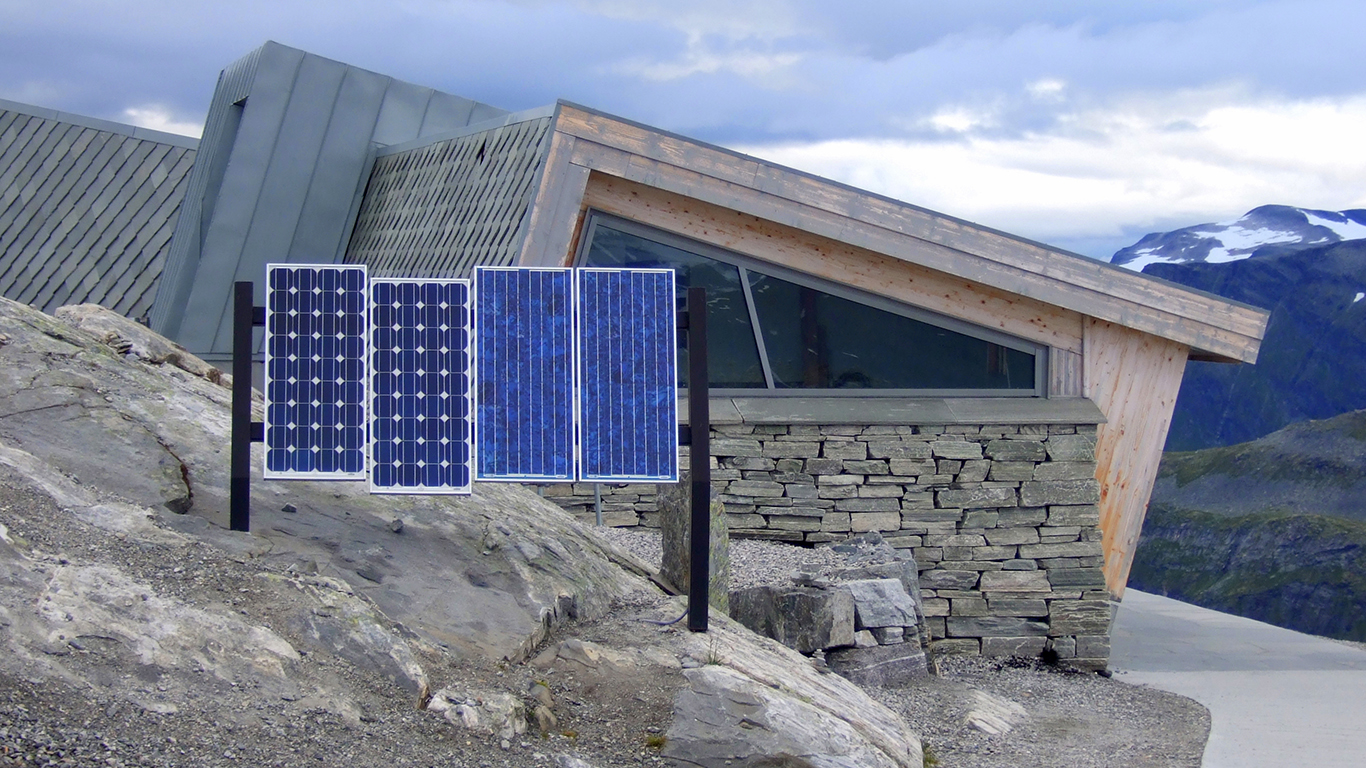
Published:
Last Updated:

No other issue other than climate change is a truly global concern. Global temperatures are projected to rise between 2.5-10 degrees Fahrenheit over the next century, according to the Intergovernmental Panel on Climate Change, a group of over 1,300 scientists from the U.S. and around the world. The impacts of climate change are already being felt and will likely only intensify over time.
The scope of the impact of climate change is difficult to overstate. Everything from wildlife, ecosystems, agriculture, and human health will all be affected on a global scale. Already the effect is felt worldwide. A global problem requires a global solution, and when it comes to protecting the environment for future generations, some countries are doing more than others.
24/7 Wall St. created an index to measure environmental performance by country using data from Yale University’s 2018 Environmental Performance Index and the World Bank’s “What a Waste Database.” The measures that comprise this index range in scope and include air quality, water quality, biodiversity, wastewater treatment, carbon emissions, and proactive environmental policies.
It is important to note that the high ranking countries on this list are not necessarily exemplary at resource management and per capita waste. Several of the countries that rank high in certain measures of environmental stewardship are some of the same countries that produce the most waste.
Addressing environmental issues costs money, and many poorer nations lack the resources necessary to tackle even the most pressing environmental problems. In fact, many of the countries doing the least to protect the environment also rank among the 25 poorest countries in the world. Conversely, many of the countries doing the most rank among the world’s richest countries.
Click here to see the countries doing the most to protect the environment.
Click here to see the countries doing the least to protect the environment.
Click here to read our methodology.
Countries Doing the Most to Protect the Environment

15. Peru
> Pop. exposed to unsafe air pollution levels: 100.0%
> Area with gov. protection: 13.1%
> GDP per capita: $12,237
Want to pollute in Peru? They’ll see you in court! Just over a year ago, the South American nation established its first specialized environmental court, aiming to add some muscle to its environmental laws as the country deals with illegal mining, deforestation, environmental degradation, and illicit trade in wildlife, mining equipment, and hazardous waste. In less than a year, the court had nearly 3,000 environmental complaints on the docket.
[in-text-ad]
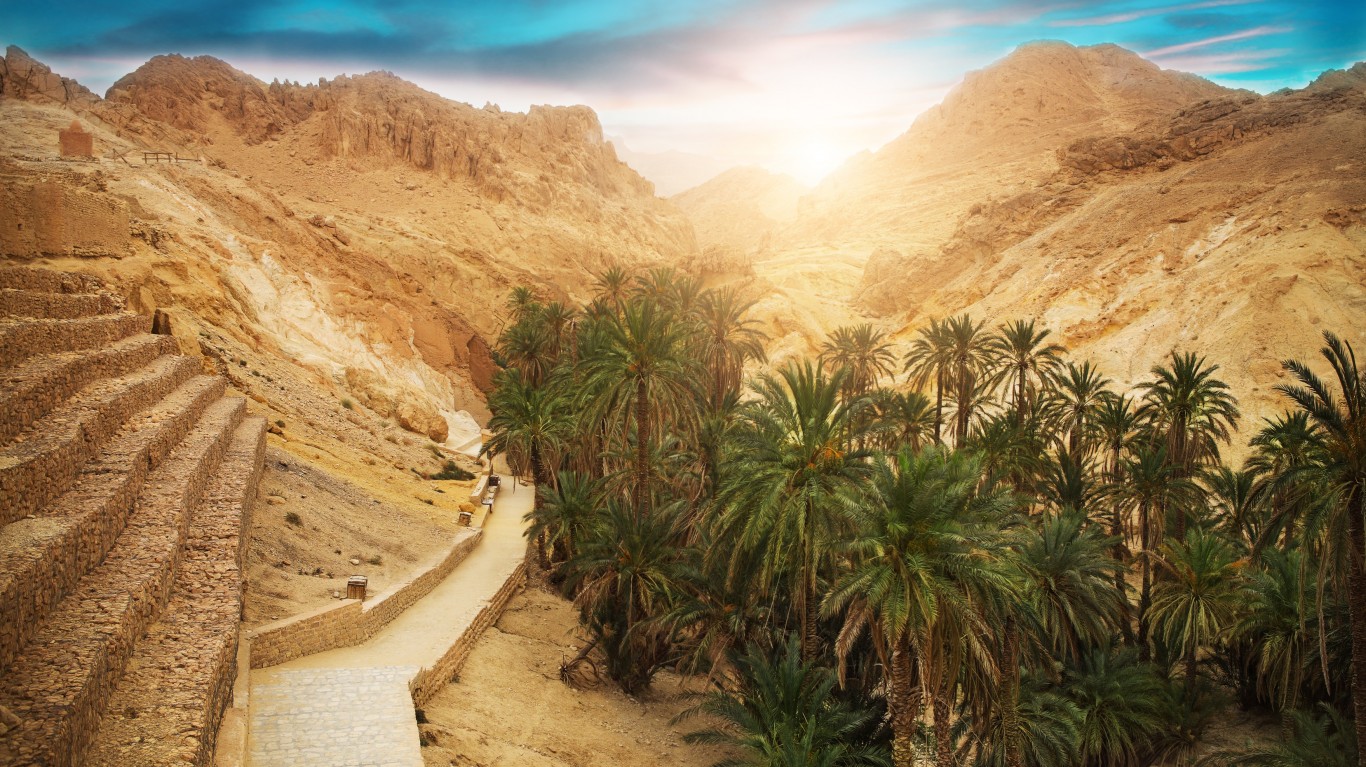
14. Tunisia
> Pop. exposed to unsafe air pollution levels: 100.0%
> Area with gov. protection: 5.2%
> GDP per capita: $10,849
Sustainable environmental policies are part of the economic and social strategies of this North
African nation, which is aiming for a balance between development and protecting natural resources. To crack down on illegal dumping, Tunisia introduced a “green police” force in 2017, with fines levied for littering or burning waste and possible imprisonment for offenses impacting public health. Other responsibilities of the green police include raising awareness of environmental and waste management issues among the general public.
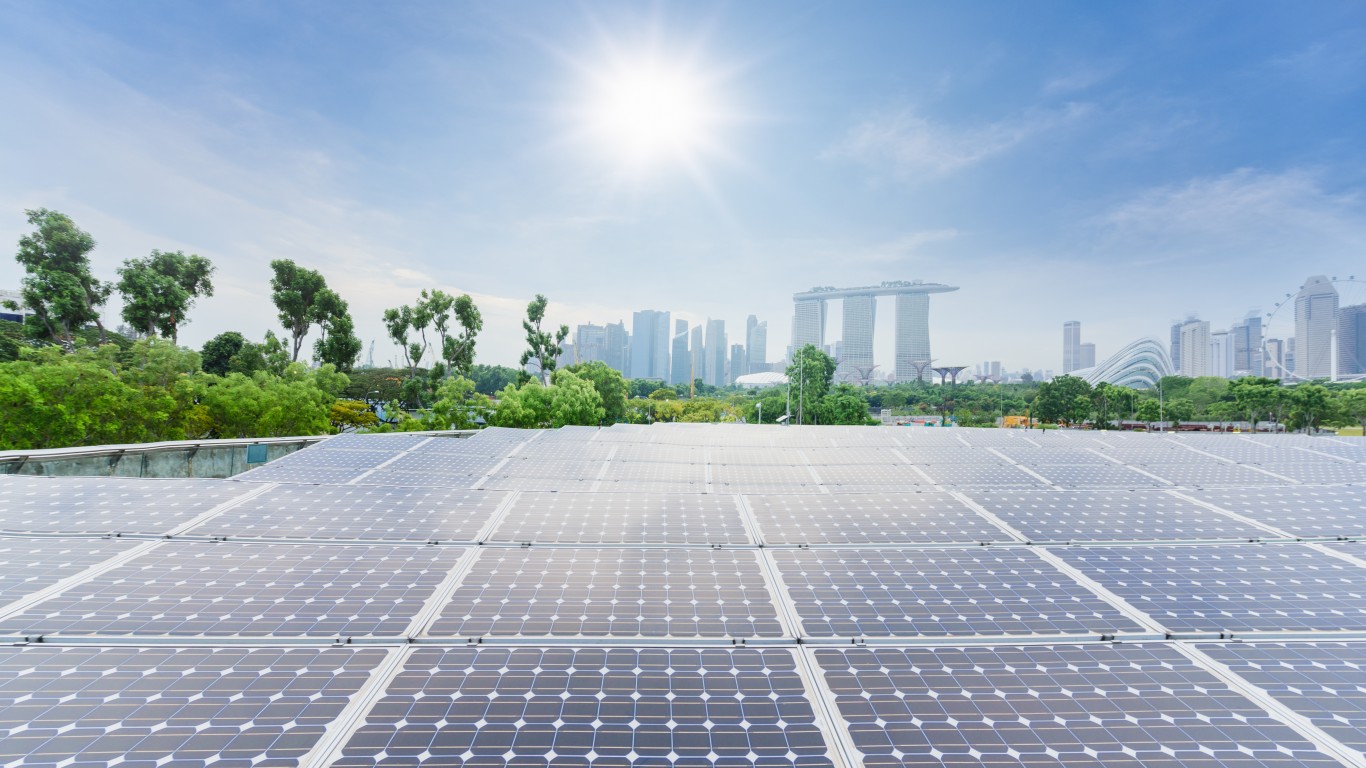
13. Singapore
> Pop. exposed to unsafe air pollution levels: 100.0%
> Area with gov. protection: 2.5%
> GDP per capita: $85,535
Between 2006 and 2016, Singapore’s emissions from fossil fuel consumption dropped by a healthy 19.1%, though sadly carbon emissions from fossil fuels and cement production soared 225.3% from 2007 to 2017. The Southeast Asian nation declared 2018 the Year of Climate Action, alerting the public to the dangers of climate change, increased regulations on discarding food, plastics, and e-waste; and turning a greater focus on sustainability. It looks as though young people are poised to take a leading role in green initiatives as 60% of students in Singapore took part in the SEC-StarHub School Green Awards, which encourages young people to turn their passion for the environment into action.
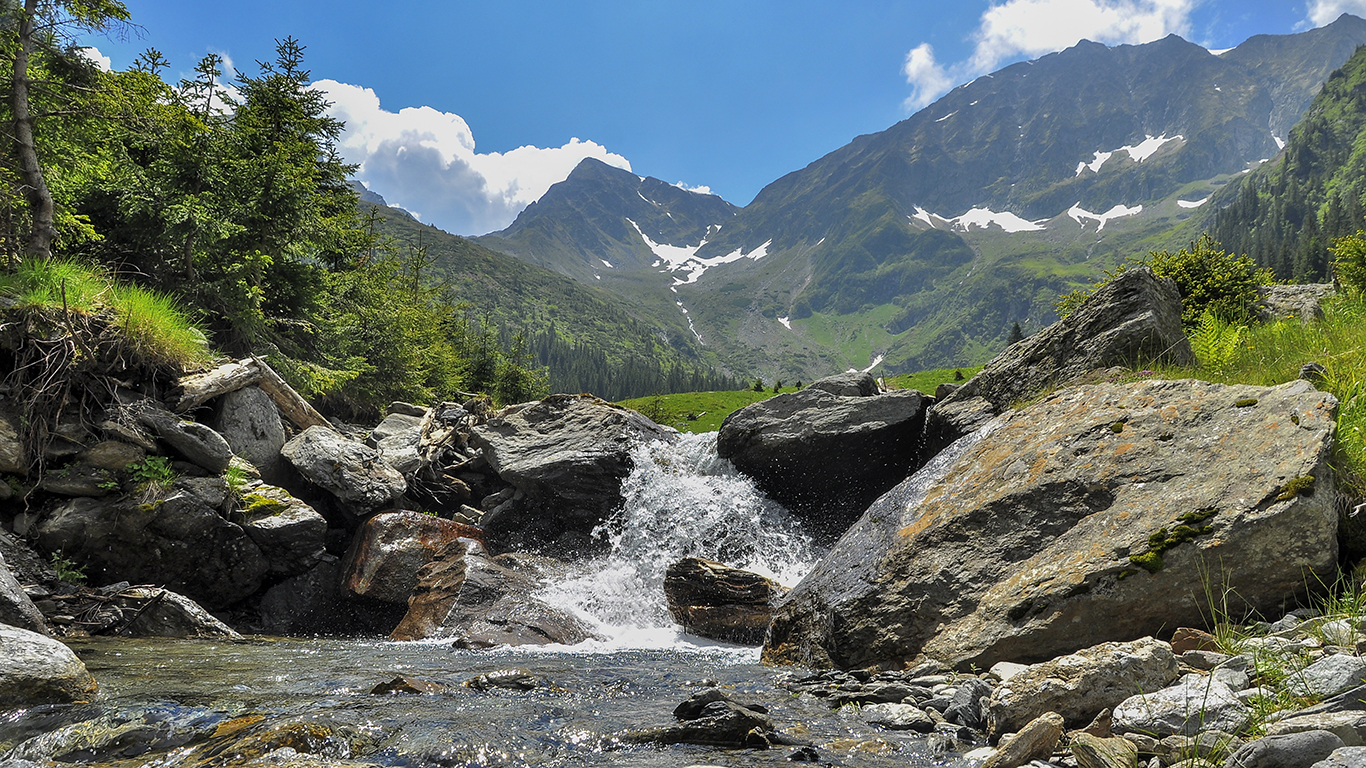
12. Romania
> Pop. exposed to unsafe air pollution levels: 98.0%
> Area with gov. protection: 24.3%
> GDP per capita: $23,505
11. Belarus (sam) done MA f/c
> Pop. exposed to unsafe air pollution levels: 99.9%
> Area with gov. protection: 9.4%
> GDP per capita: $17,175
Romania is working with the World Bank to reach its goals in fighting climate change and striving for low-carbon development. Among the collaboration’s objectives are developing an environmental strategy and action plan, identifying carbon-trading opportunities, and building a knowledge base for impact assessment and decision making. More than 24% of Romania’s terrestrial and marine areas are protected, and between 2006 and 2016, carbon emissions from fossil fuel consumption dropped by more than 33%. The level of carbon emissions from fossil fuels and cement production is also down by 26.3%. Industry-related air and water pollution in Romania is linked to acid rain, high greenhouse-gas levels, and industrial runoff into the river system.
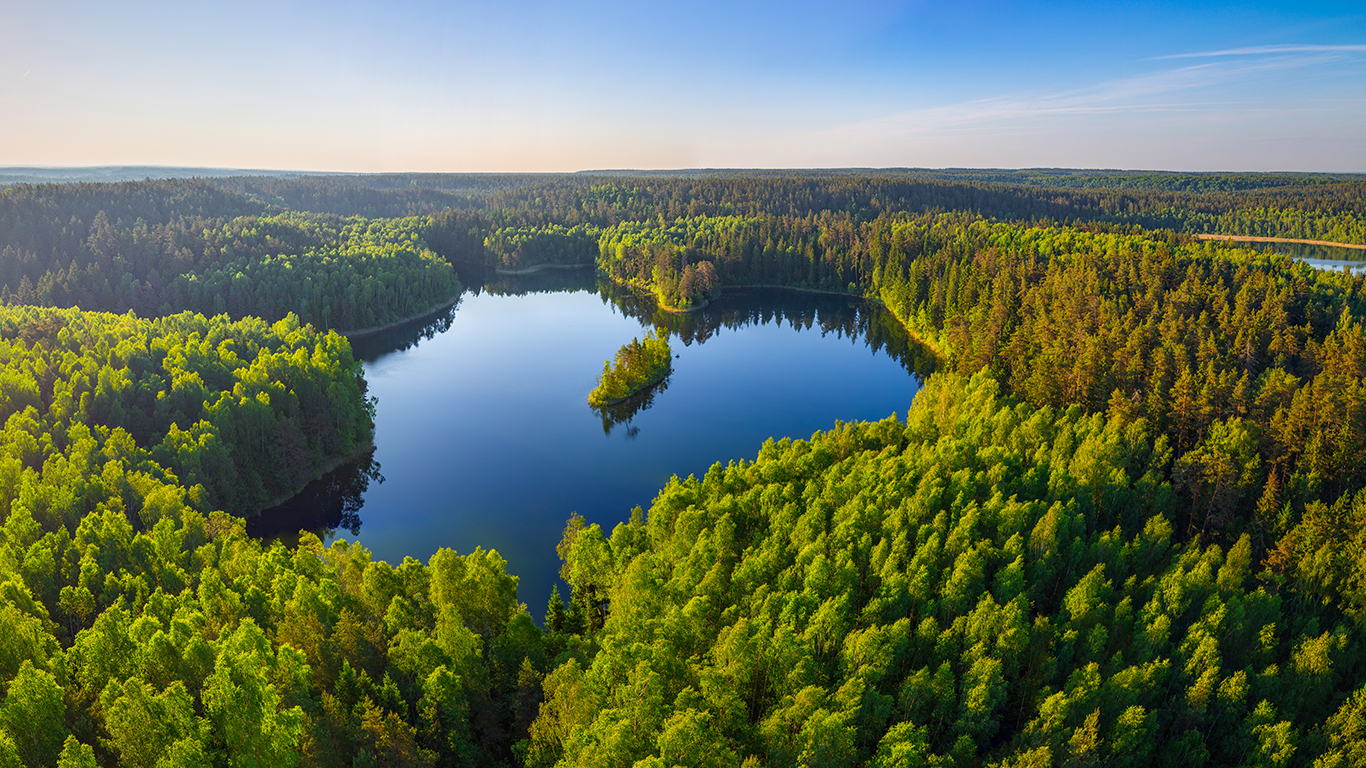
11. Belarus
> Pop. exposed to unsafe air pollution levels: 99.9%
> Area with gov. protection: 9.4%
> GDP per capita: $17,175
Belarus is one of several countries that benefited from the United Nations Development Programme, which aimed to promote economic growth through environmentally sustainable means. The project, which stretched from 2014 to 2017, resulted in nearly two-dozen pilot projects, including a motor oil collection and processing system in the Barysau and Krupki Districts and the country’s first forest educational center in Horni Park, Lida District. The project also created 50 new green jobs.
Additionally, the presence of dangerous fine particulate matter declined by 40.8% in the country from 1990 to 2016.
[in-text-ad-2]
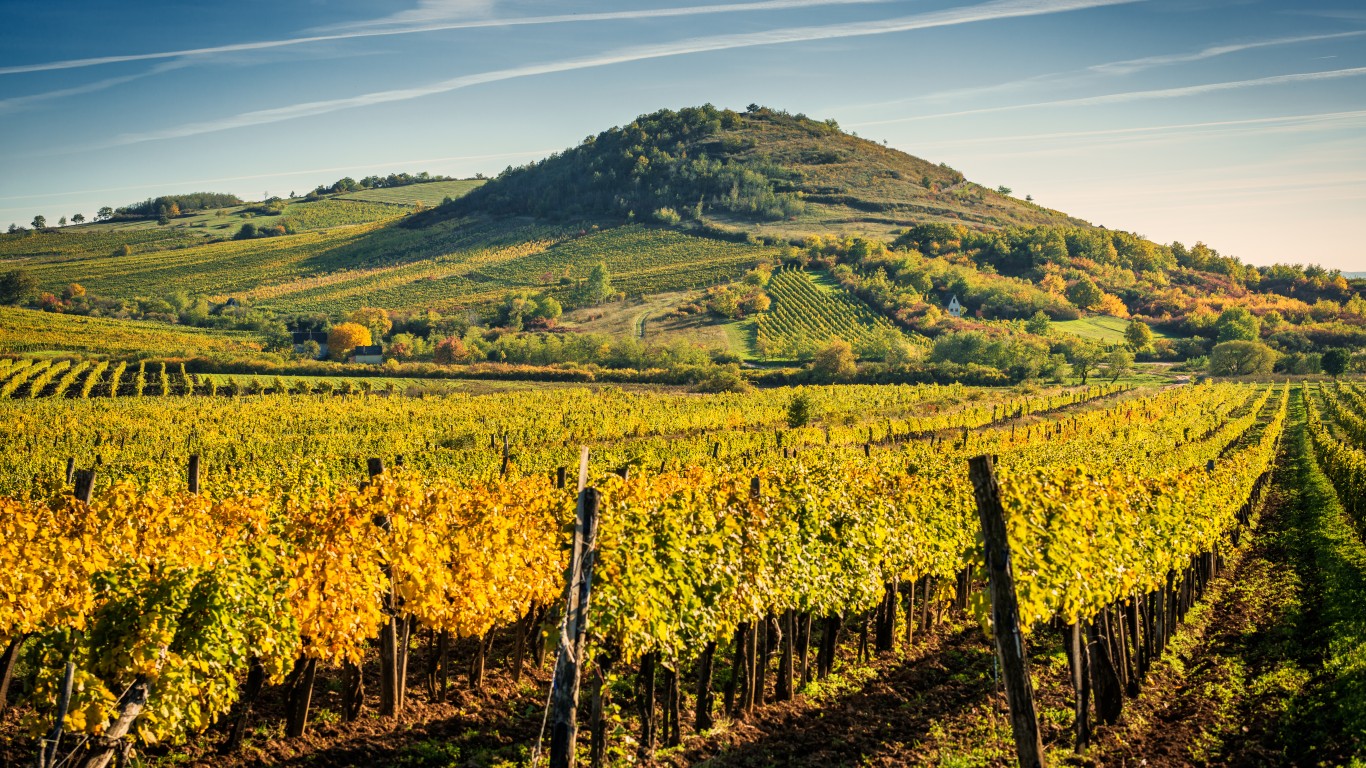
10. Hungary
> Pop. exposed to unsafe air pollution levels: 100.0%
> Area with gov. protection: 22.6%
> GDP per capita: $26,861
Hungary has made considerable progress in environmental protection in recent years. The landlocked central European country has managed to reduce its greenhouse gas emissions by 35% since 1990. Additionally, the country is on track to more than meet or exceed its goal of 14.7% renewable energy by 2020. Hungary is also exemplary in its protection of its land. Slightly more than 22% of the country’s territory is protected by the government, a larger than typical share.
Still, as is the case with every country on this list, more progress needs to be made. Fossil fuels still account for over 70% of Hungary’s energy, and the country has one of the worst mortality rates due to air pollution among OECD countries.

9. Trinidad and Tobago
> Pop. exposed to unsafe air pollution levels: 100.0%
> Area with gov. protection: 2.0%
> GDP per capita: $28,763
A regional leader in environmental protection, Trinidad and Tobago is the only Caribbean nation to rank on this list. Economic growth has historically been driven by environmentally harmful means, such as mining and deforestation. Now the country is shifting toward more environmentally sustainable growth practices, which the island nation’s government acknowledges is essential for both businesses and communities in the country.
The government is leading by example, pledging to conserve resources and energy, adhere to sustainable waste management practices, reduce pollution, and reduce output of harmful greenhouse gases. The presence of dangerous fine particulate air pollution declined by 13.3% in the country from 1990 to 2016.
[in-text-ad]
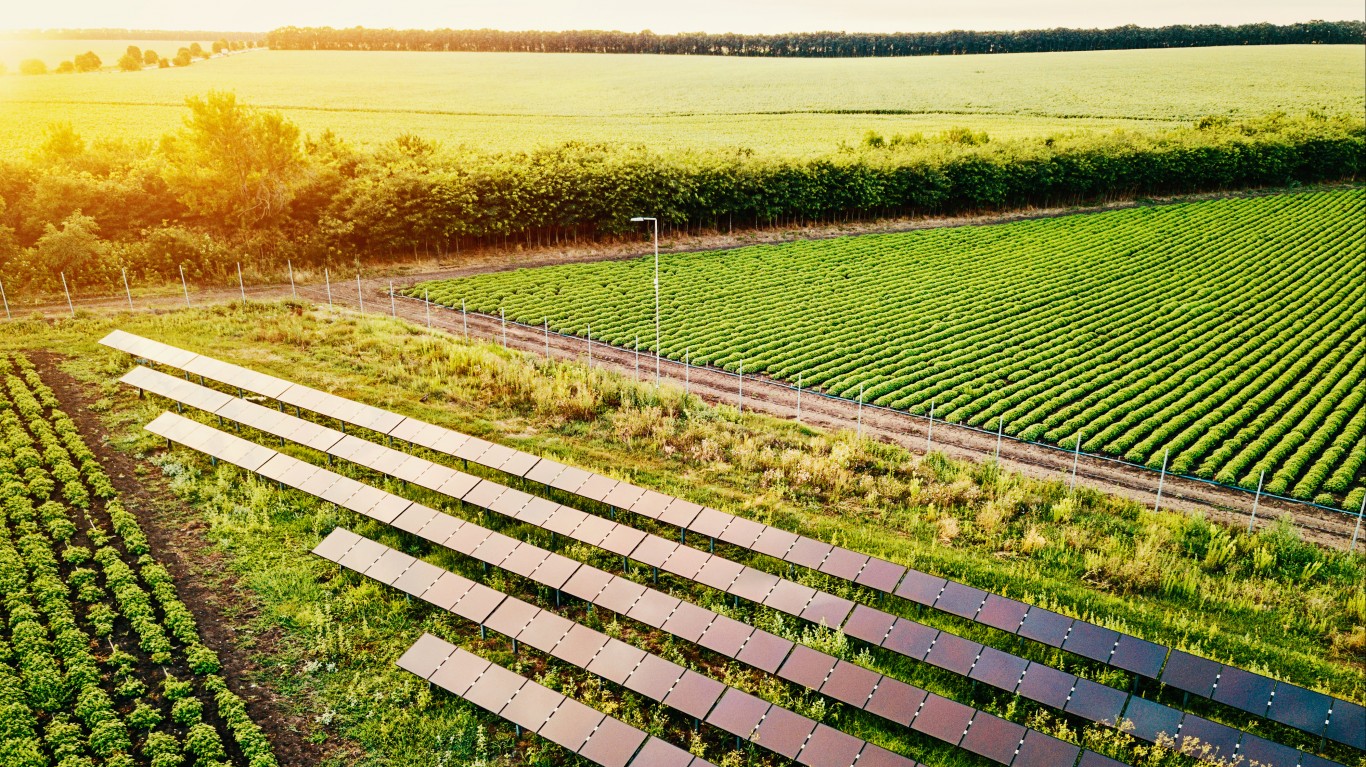
8. Bulgaria
> Pop. exposed to unsafe air pollution levels: 99.9%
> Area with gov. protection: 28.3%
> GDP per capita: $18,606
Since joining the European Union in 2007, Bulgaria has made significant strides toward developing an environmentally sustainable economy, in accordance with EU directives, including working towards the goal of 16% renewable energy by 2020. Results are already evident. The presence of dangerous PM2.5 air pollution declined by 43.3% in the country from 1990 to 2016.
The Bulgarian government also protects much of its land. Over 28% of the country’s lands are reserves with limited public access like national parks, wildlife sanctuaries, protected landscapes, and areas managed for sustainable use.
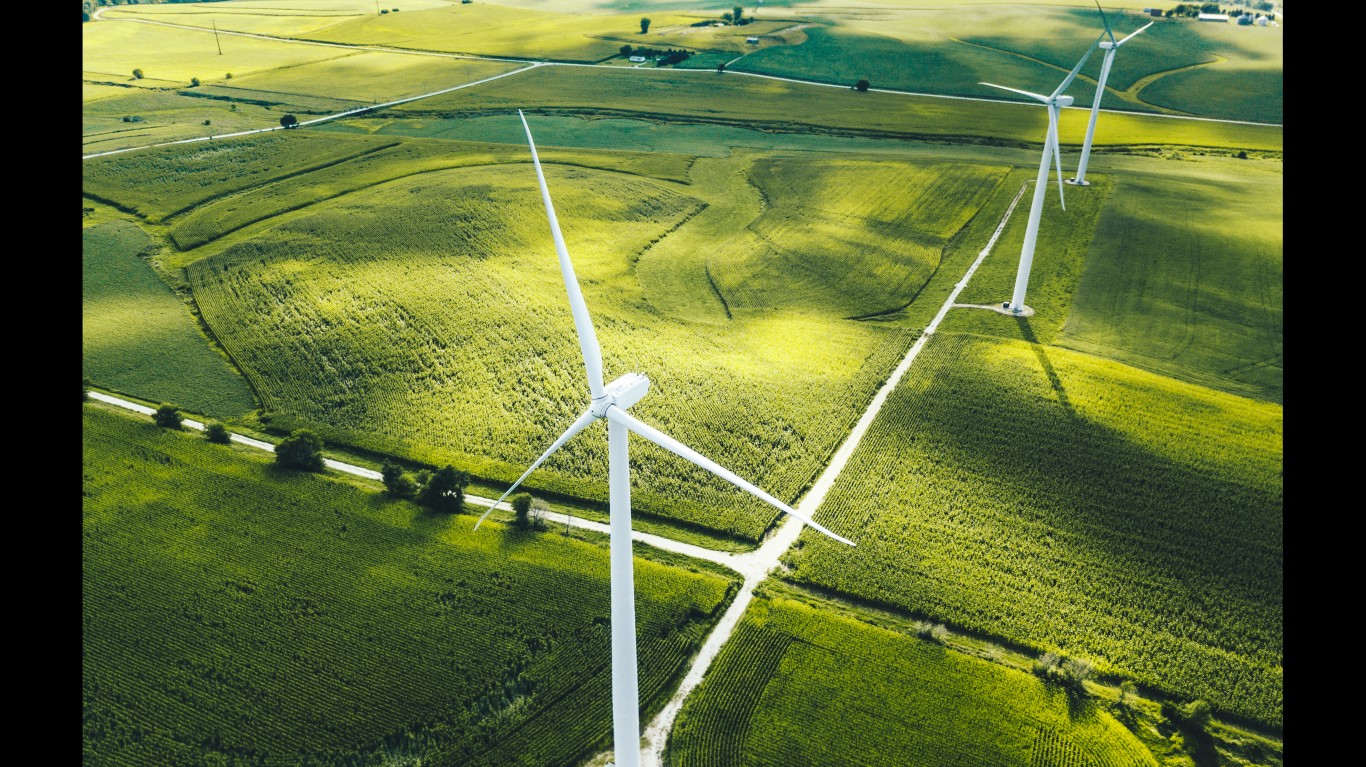
7. United States
> Pop. exposed to unsafe air pollution levels: 3.3%
> Area with gov. protection: 26.3%
> GDP per capita: $54,471
Despite the internationally criticized 2017 decision to withdraw from the Paris Agreement — a multinational accord to collectively combat global warming — the U.S. ranks among the 10 countries doing the most to protect the environment. Over a quarter of U.S. territory is protected reserves with limited public access like national parks, wildlife sanctuaries, and areas managed for sustainable use, a larger share than most countries. Additionally, only 3.3% of the U.S. population are exposed to unsafe levels of air pollution.
Under the Trump Administration’s 2020 budget proposal, funding for the Environmental Protection Agency will be slashed by 31%. Should these cuts take effect, the U.S. may not remain one of the global leaders in environmental protection for long.

6. Canada
> Pop. exposed to unsafe air pollution levels: 0.0%
> Area with gov. protection: 6.5%
> GDP per capita: $44,018
Though only 6.5% of the terrestrial and marine areas are protected in Canada, that’s still a lot of area when you take into consideration it is the second largest country on the globe in landmass. The country comprises burgeoning urban areas, the fragile Arctic Circle, and a variety of terrains in between. Environmental achievements include supporting climate-friendly technology leading to energy efficiency, renewable energy, and sustainable urban transportation; reducing greenhouse gas emissions; and providing biodiversity planning and protection for land and sea. Challenges include rapid warming in the formerly frozen-solid north, the impact of air pollution on wildlife, vegetation, water and soil, and acid rain.
[in-text-ad-2]

5. Australia
> Pop. exposed to unsafe air pollution levels: 24.9%
> Area with gov. protection: 29.7%
> GDP per capita: $44,643
Right behind its neighbor New Zealand, Australia has the second highest percentage of protected terrestrial and marine areas of countries on this list. There was, however, an 8.4% increase in consumption emissions between 2006 and 2016 and a 3.2% hike in carbon emissions from fossil fuel and cement production. Earlier this year, a report by the OECD condemned Australia’s record on emissions and declared the country not on the right path to meet its 2030 goals under the Paris agreement. But the country has also been cited for its environmental achievements, including its plastic bag ban, its strategy to halve food waste, and the construction of the world’s largest lithium battery to more effectively store wind energy.
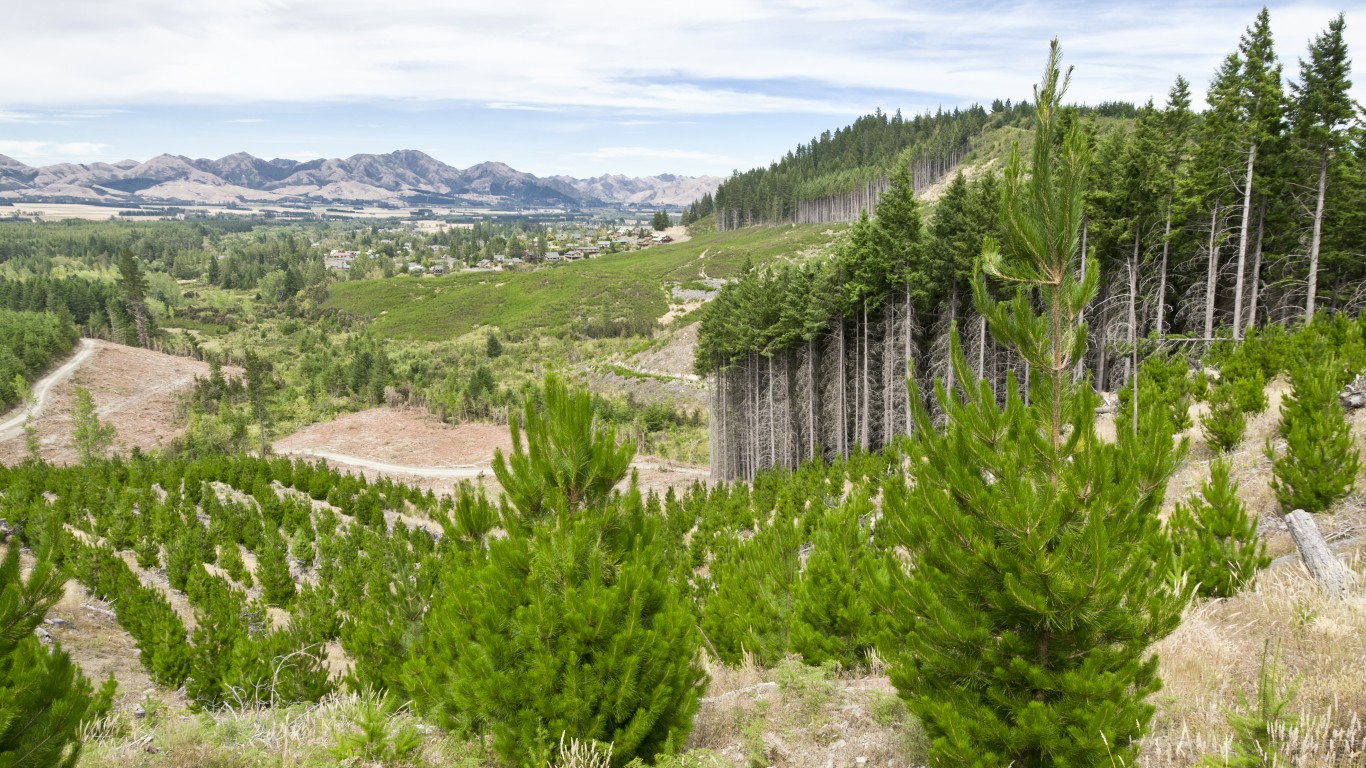
4. New Zealand
> Pop. exposed to unsafe air pollution levels: 0.0%
> Area with gov. protection: 30.5%
> GDP per capita: $36,013
Watching “The Lord of the Rings” and “The Hobbit” movies may be as close as many of us will get to enjoying New Zealand’s pristine air, but apparently those sparkling, clean skies are real and not CGI, as evidenced by the 0% of the population exposed to unsafe fine particle air pollution levels. Almost one-third of the terrestrial and marine area is protected, the highest share among the top 15 countries doing the most to protect the environment. New Zealand met targets for reducing greenhouse emissions set under the first Kyoto Protocol, and it has set additional reduction goals for 2020, 2030, and 2050. Still, even if you’re doing a great job, there’s always room for improvement. The WWF notes that deforestation, soil erosion, and destruction of wildlife habitats continue to be problems.
[in-text-ad]
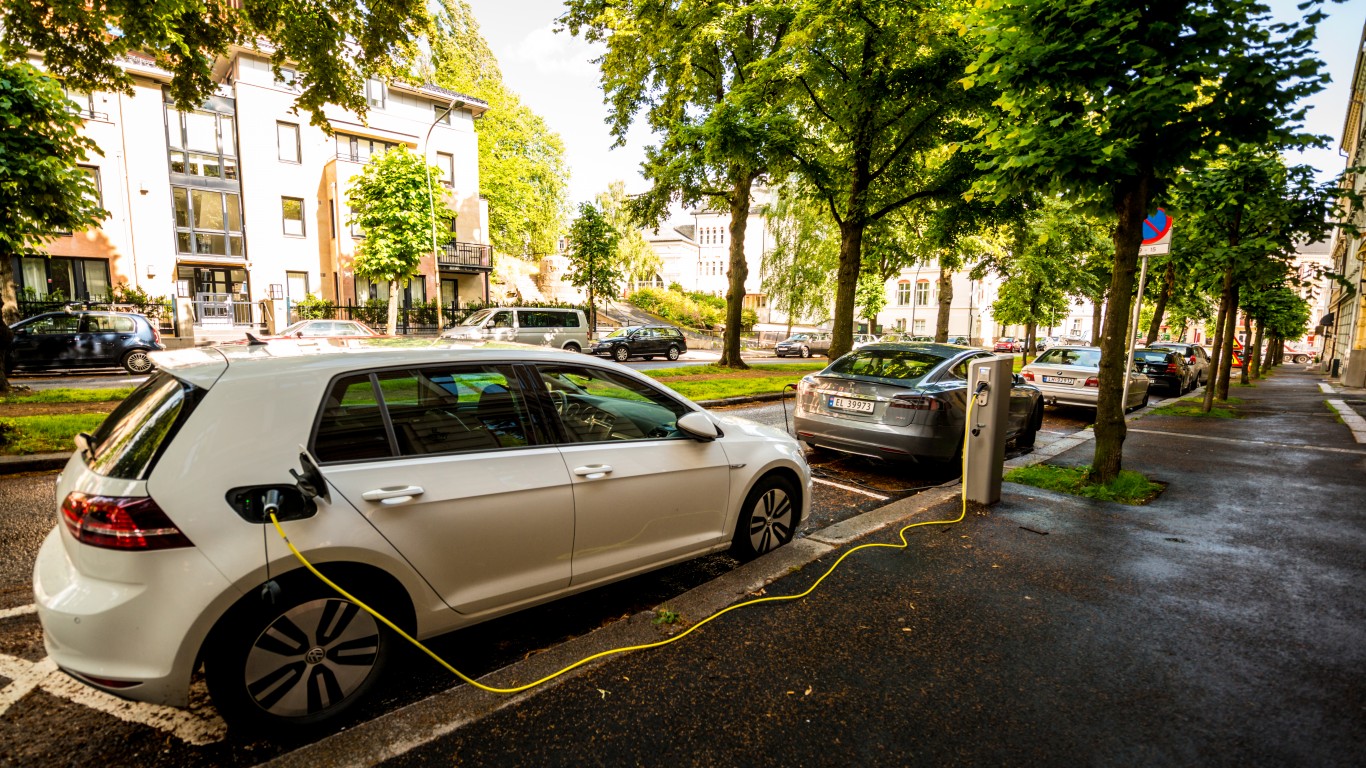
3. Norway
> Pop. exposed to unsafe air pollution levels: 2.0%
> Area with gov. protection: 5.1%
> GDP per capita: $64,965
Thanks to an abundance of hydro power, Norway’s power system is practically 100% renewable. Nevertheless, the northern nation has somewhat higher per capita greenhouse emissions than other countries in Europe and Asia. Norway, which signed the Kyoto Protocol, hopes to reduce that number in the coming year. Carbon neutrality by 2050 is another goal. With that said, only 5.1% of the terrestrial and marine areas in Norway are protected, among the lowest percentages of the 15 countries doing the most to protect the environment.
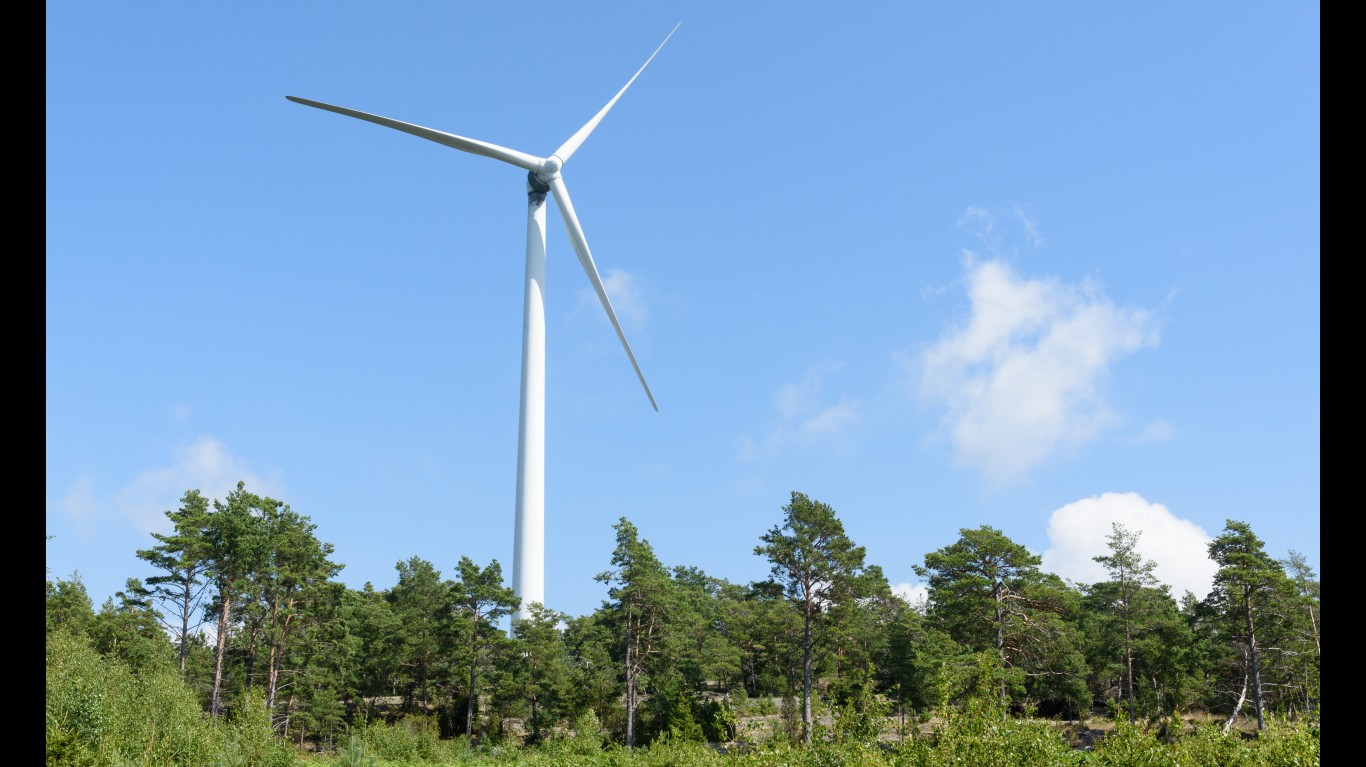
2. Finland
> Pop. exposed to unsafe air pollution levels: 0.0%
> Area with gov. protection: 14.2%
> GDP per capita: $41,018
Finland is known as one of the most environmentally friendly countries on Earth thanks largely to its almost unbelievable achievement of having 0% of its population exposed to unsafe levels of fine particle air pollution, according to the WHO. One of the world’s wealthiest industrialized countries, Finland clearly has the wherewithal to support vigorous green policies, aiming to anticipate risks and prevent damage before any harm is done. Ongoing environmental goals include reducing per capita greenhouse emissions, significantly increasing the use of renewable energy, and protecting forest and farmland habitats.

1. Denmark
> Pop. exposed to unsafe air pollution levels: 56.9%
> Area with gov. protection: 17.9%
> GDP per capita: $47,270
Denmark already ranked high when we reported on this topic in 2017. The country has continued to make strides forward, in air quality in particular. On the previous report, 78.8% of the population was exposed to unsafe levels of fine particle air pollution; now, the figure has dropped to 56.9%. Denmark tops the list of countries doing the most to protect the environment, and continues to set ambitious goals, among them having at least half its energy consumption come from renewables by 2030 and to be independent of fossil fuels by 2050.
Countries Doing the Least to Protect the Environment
[in-text-ad-2]
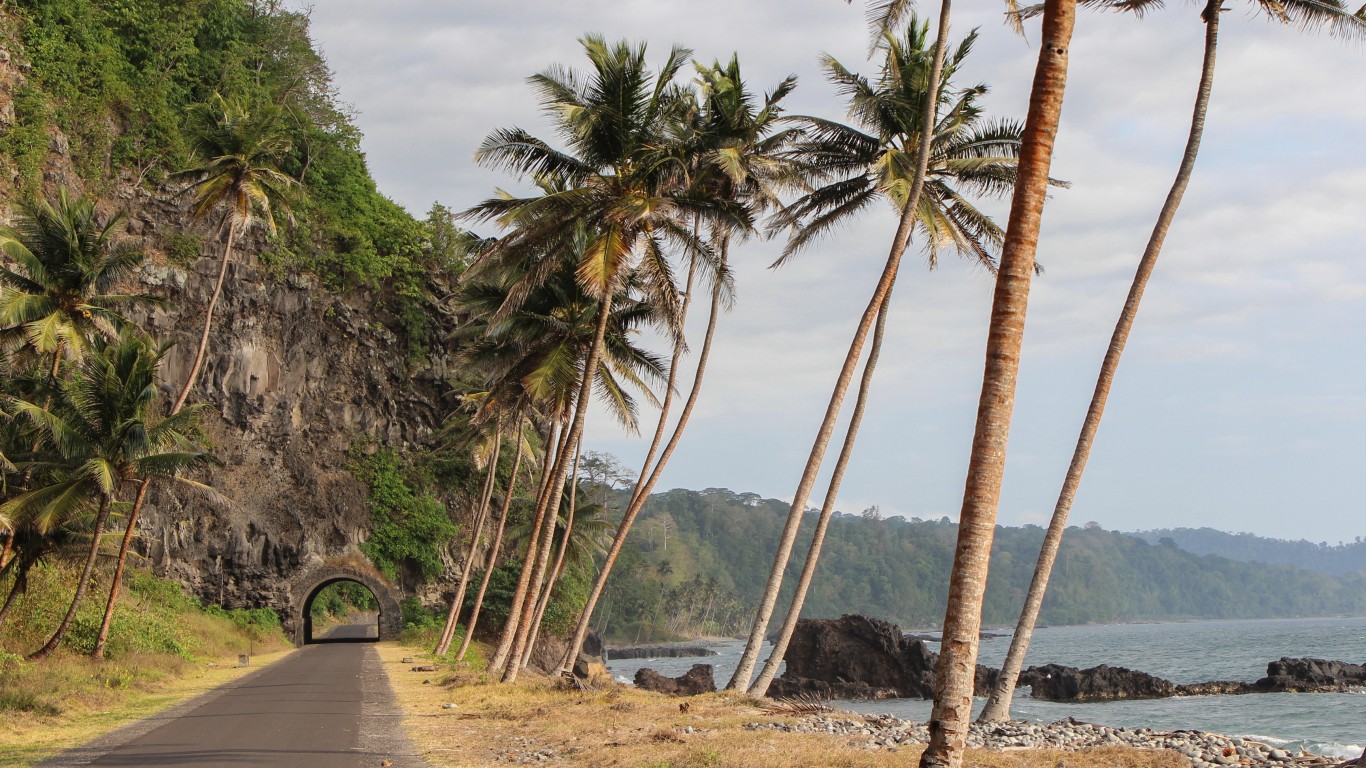
15. Sao Tome and Principe
> Pop. exposed to unsafe air pollution levels: 100.0%
> Area with gov. protection: 0.2%
> GDP per capita: $3,053
There’s a clear link between a nation’s wealth and its ability to protect the environment, so it’s no surprise that Sao Tome and Principe, with its tiny per capita GDP of just over $3,000, ranks among the worst in the world. About 50% of the land is used for agriculture in this small island nation that is less than 1,000 square kilometers, roughly five times larger than Washington D.C. Situated off the west coast of Africa, Sao Tome and Principe’s environmental challenges include deforestation, soil erosion, and inadequate treatment of sewage in urban areas.
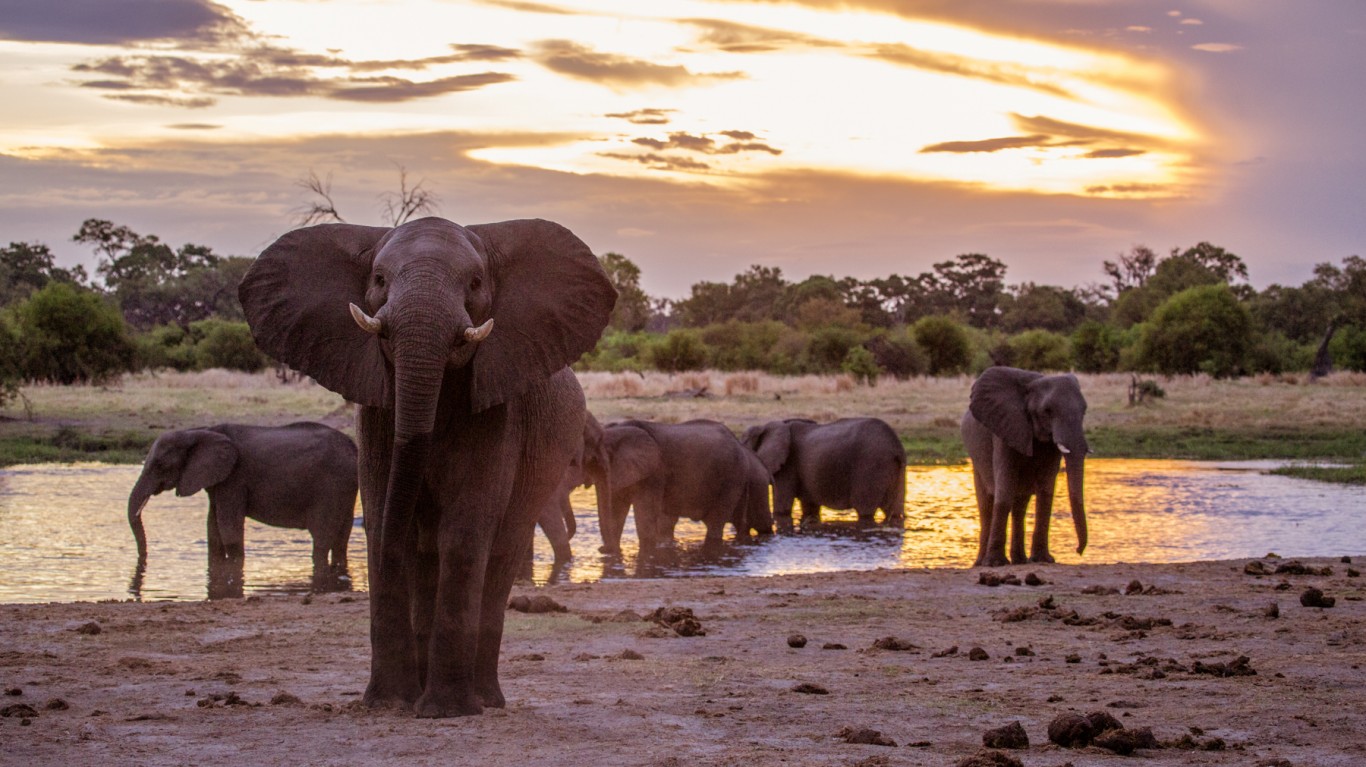
14. Botswana
> Pop. exposed to unsafe air pollution levels: 100.0%
> Area with gov. protection: 29.1%
> GDP per capita: $15,474
Botswana shares a daunting statistic with the other 14 countries doing the least to protect their environment: 100% of its population is exposed to air pollution levels exceeding the World Health Organization’s guidelines. But it ranks among the highest in this group when it comes to the percentage of the protected terrestrial and marine area. Despite that, the southern African nation is likely to find itself embroiled in conservationist controversy for the foreseeable future following its May 22 decision to end its ban on elephant hunting.
[in-text-ad]

13. Sudan
> Pop. exposed to unsafe air pollution levels: 100.0%
> Area with gov. protection: 2.8%
> GDP per capita: $4,467
Sudan is a nation in turmoil. South Sudan split off from Sudan in 2011, taking a big piece of oil revenue with it. A civil war broke out in South Sudan in 2013, and Sudan has become a destination for refugees and asylum seekers. The northern African country’s resources are stretched thin by this series of events, but it is supported by the UN in preparing its first State of the Environment and Outlook Report, aiming to help the government make informed decisions and adopt an integrated approach to understanding the link between social and economic development.
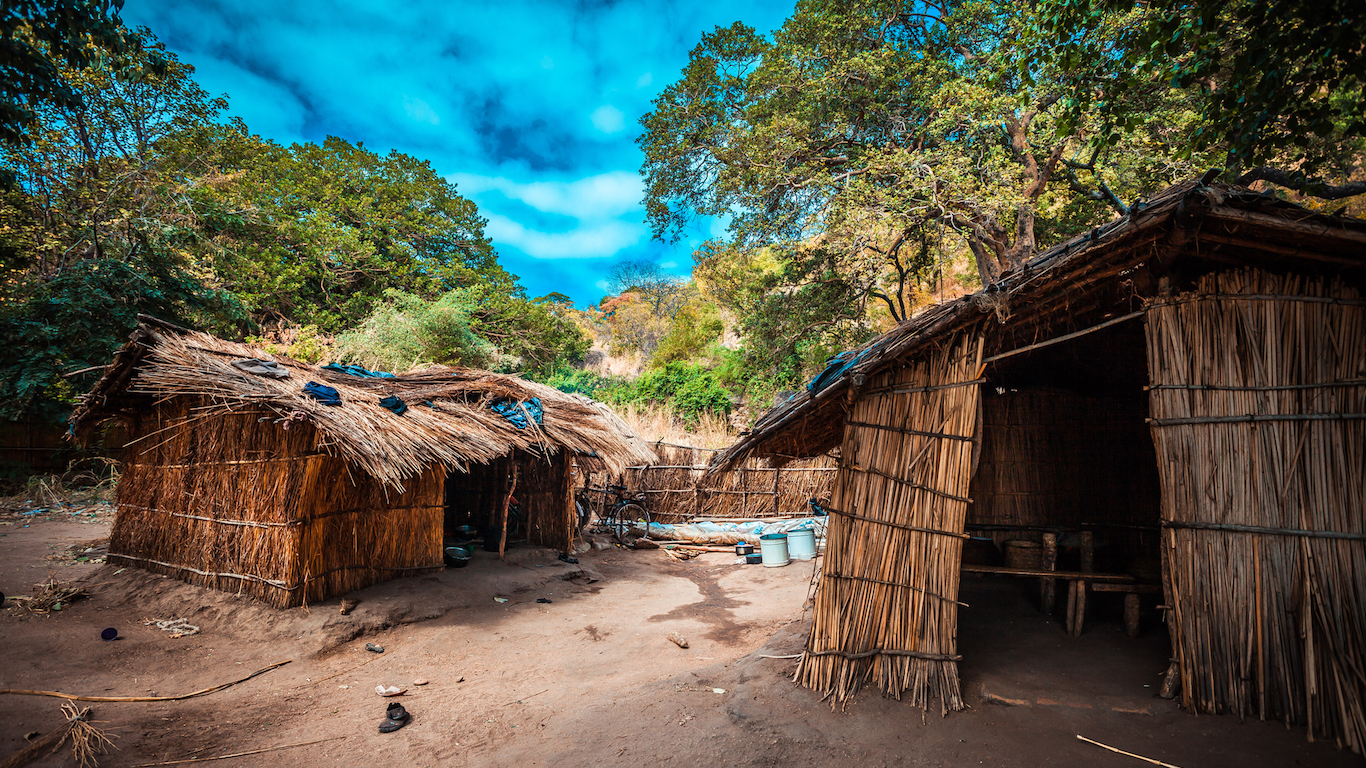
12. Malawi
> Pop. exposed to unsafe air pollution levels: 100.0%
> Area with gov. protection: 22.9%
> GDP per capita: $1,095
The simple and necessary act of cooking a meal is a source of environmental concern in Malawi, one of the world’s poorest countries. Very few people in the country have access to electricity, so most meals are prepared on wood fires. The demand for wood and charcoal contributes to deforestation, with an estimated 3% of Malawi’s forests lost each year. And the smoke from the wood fires takes its toll on air quality, releasing hundreds of substances into the air, including particulates, soot, carcinogens, carbon monoxide, and hydrocarbons, leading to lung disease, with women and children particularly susceptible.
Among Malawi’s sustainable development goals are ensuring access to modern, sustainable, affordable and reliable energy for all and enact sustainable water management practices.
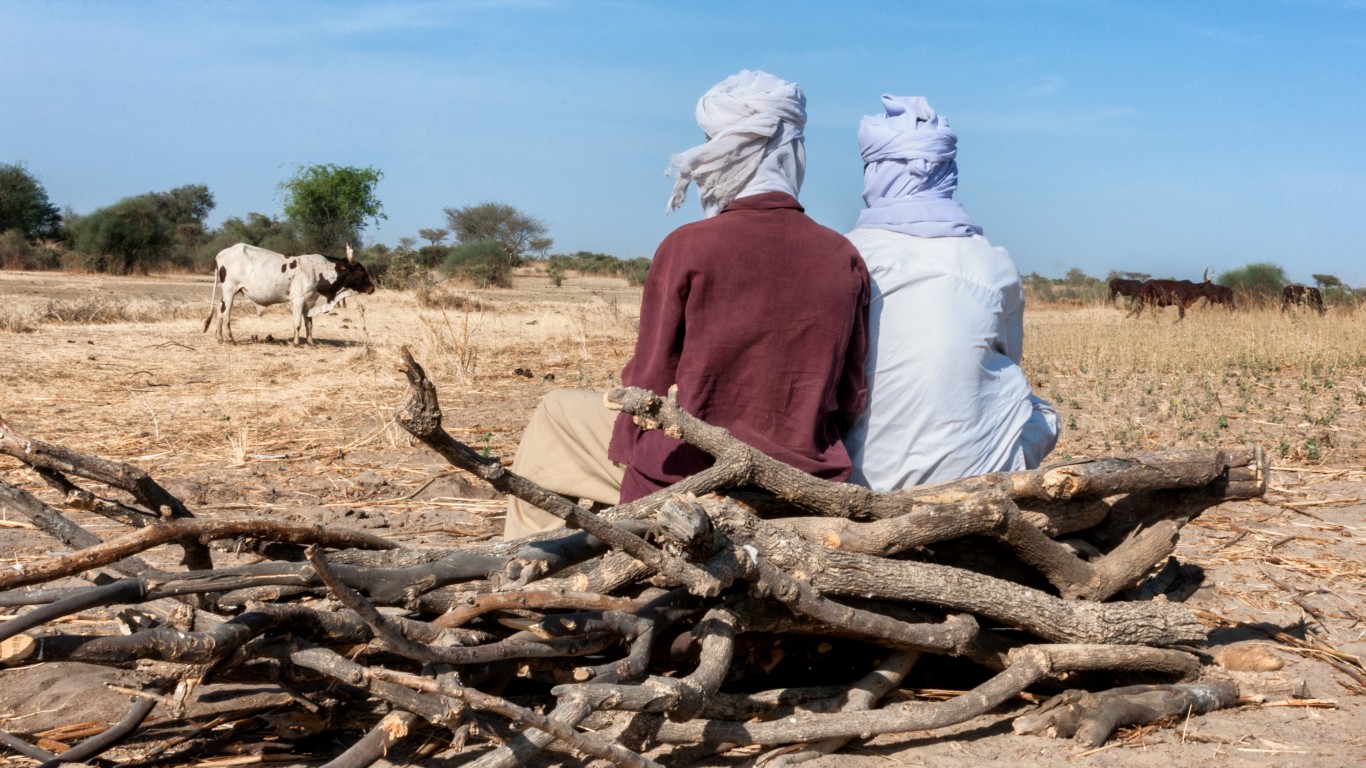
11. Chad
> Pop. exposed to unsafe air pollution levels: 100.0%
> Area with gov. protection: 20.4%
> GDP per capita: $1,768
The good news is that in the years since 24/7 Wall St. last reported on the countries doing the least to protect the environment, Chad has increased its terrestrial and marine-protected areas — from 17.8% of land to 20.4% today.
The bad news is that only 9.5% of the population has access to basic sanitation, and many deaths are related to unsafe water and sanitation and the lack of hygienic conditions. Chad’s environmental goals include reducing air pollution from vehicle emissions, dropping lead levels in fuel, and lowering emissions from biomass burning.
[in-text-ad-2]

10. Guinea-Bissau
> Pop. exposed to unsafe air pollution levels: 100.0%
> Area with gov. protection: 11.6%
> GDP per capita: $1,549
Environmental protections are necessities that can feel like luxuries in desperately poor countries, where a large percentage of the population lacks regular access to food, potable water, and basic sanitation. Add political instability to the equation and it’s easy to imagine sustainability and green policies sliding down the priority list. Guinea-Bissau fits that description, with almost 70% of the population living below the poverty line and as much as half of the population food-insecure in some regions. The West African country has been in chronic political turmoil since it gained independence in 1974.
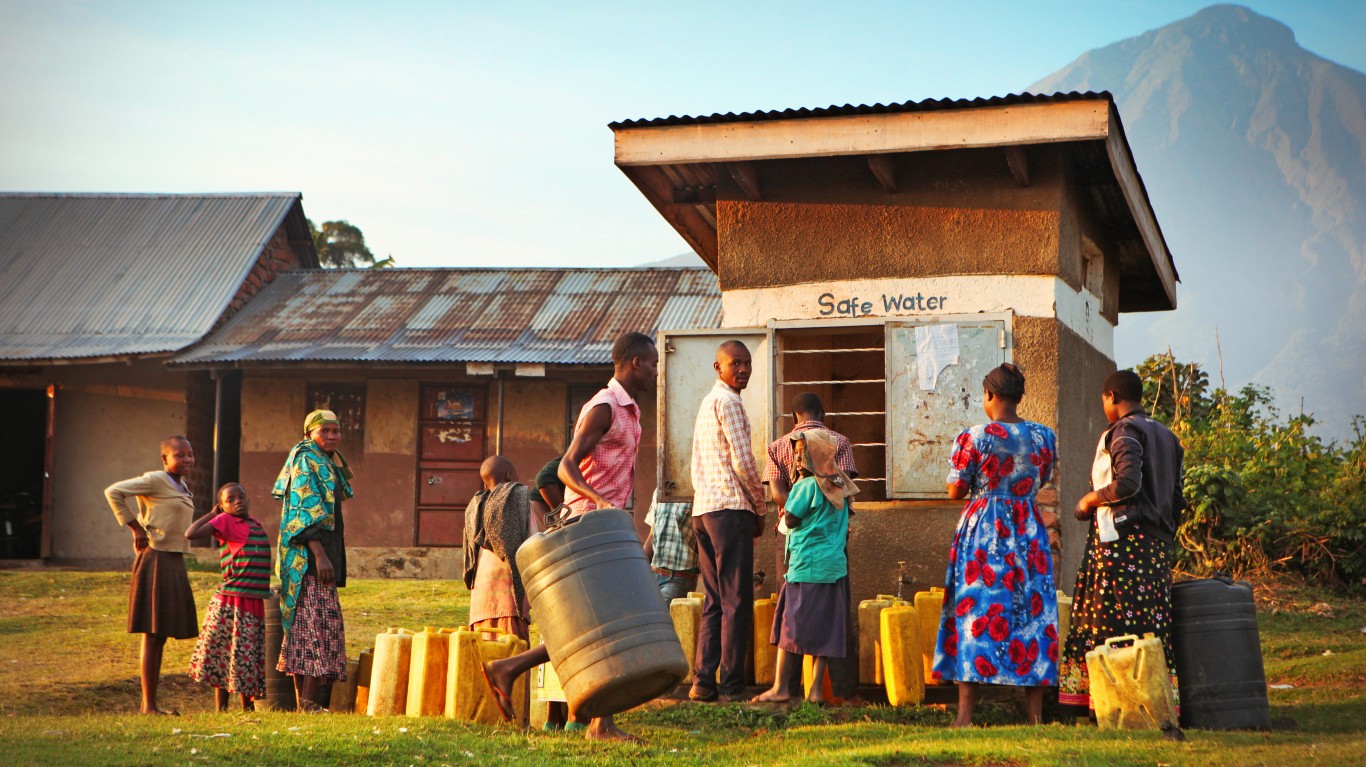
9. Uganda
> Pop. exposed to unsafe air pollution levels: 100.0%
> Area with gov. protection: 16.1%
> GDP per capita: $1,698
Uganda is one of several African nations lagging behind most countries in the world in terms of environmental protection efforts. Between 1990 and 2016, a period over which most countries reported improved air quality, the concentration of harmful fine air pollution known as PM2.5 increased by 21.3% in Uganda. Rapid population growth in the country is leading to mass deforestation, and oil exploration in the Albertine Rift Valley continues as the country has an evident lack of alternative energy sources.
[in-text-ad]
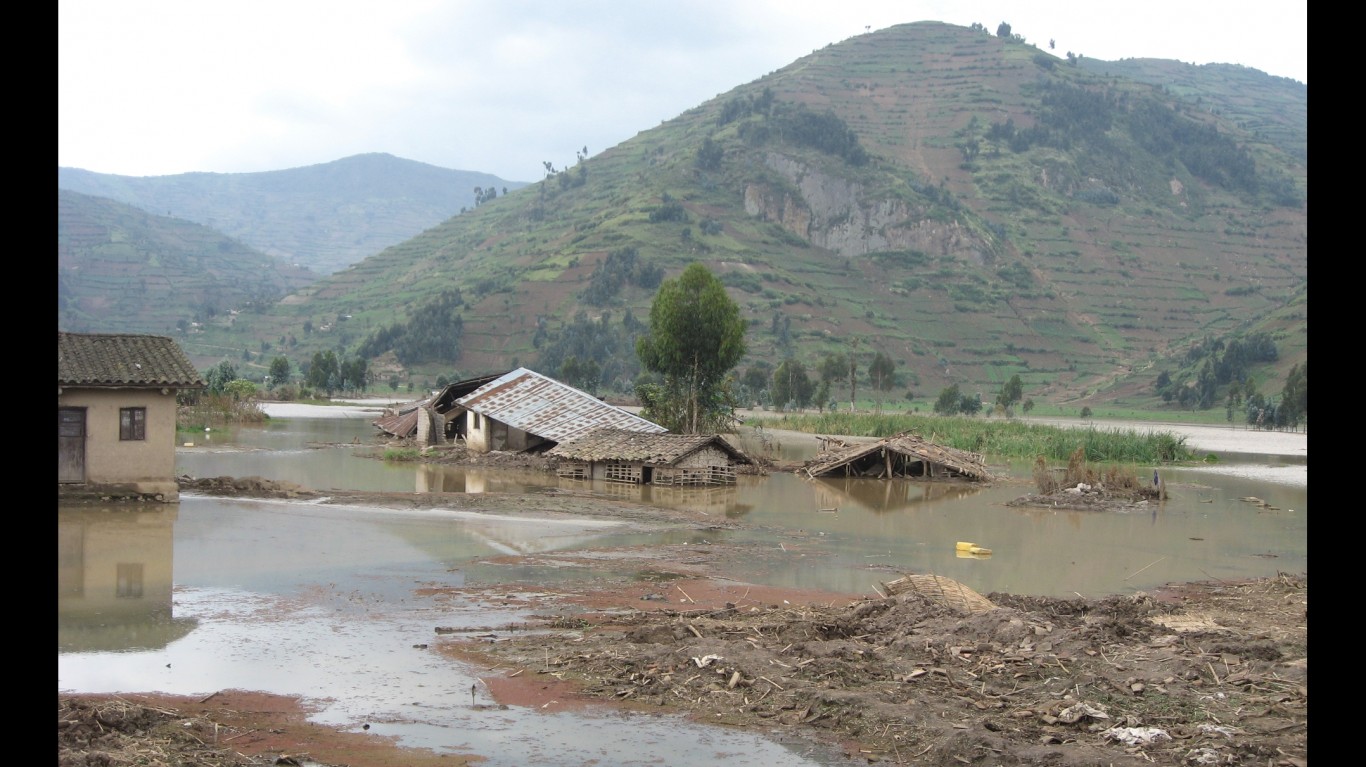
8. Rwanda
> Pop. exposed to unsafe air pollution levels: 100.0%
> Area with gov. protection: 9.1%
> GDP per capita: $1,857
As in many other African nations on this list, many of Rwanda’s environmental problems stem from rapid population growth straining natural resources. Major issues include deforestation, loss of biodiversity, reduced soil fertility, and poaching. Even though the country faces considerable threats from climate change, it’s not well equipped to address the increased frequency and severity of floods and droughts within its borders.
Many of the Rwandan government’s initiatives to combat environmental deterioration, like increasing forest cover to 30% by 2020, are being stymied by rapid population growth.

7. Iraq
> Pop. exposed to unsafe air pollution levels: 100.0%
> Area with gov. protection: 1.5%
> GDP per capita: $15,393
Less than 2% of land in Iraq is protected by the government, among the least of any country in the world. Protected lands include reserves with limited public access like national parks, wildlife sanctuaries, protected landscapes, and areas managed for sustainable use.
Environmental challenges in the country are also a product of several recent wars, poor land use planning, and the destructive human impact on unprotected fragile ecosystems. Currently, the country faces water quality and shortage issues, poor soil, and ecosystem deterioration. These problems are expected to only get worse as a result of global warming.

6. Sierra Leone
> Pop. exposed to unsafe air pollution levels: 100.0%
> Area with gov. protection: 3.3%
> GDP per capita: $1,391
The government of Sierra Leone has protected only 3.3% of the country’s territory from environmental damage, a far smaller share than most countries. Indeed, much of the country’s environmental problems are a product of unrestricted mineral excavation — specifically diamonds — and resulting deforestation. Recently, a mudslide attributable to deforestation killed over 1,000 people in the country and displaced nearly 5,000 others.
Sierra Leone is among the world’s poorest countries, and many who live there rely on untreated, polluted water supplies. Additionally, everyone living in the country is exposed to unsafe levels of air pollution.
[in-text-ad-2]
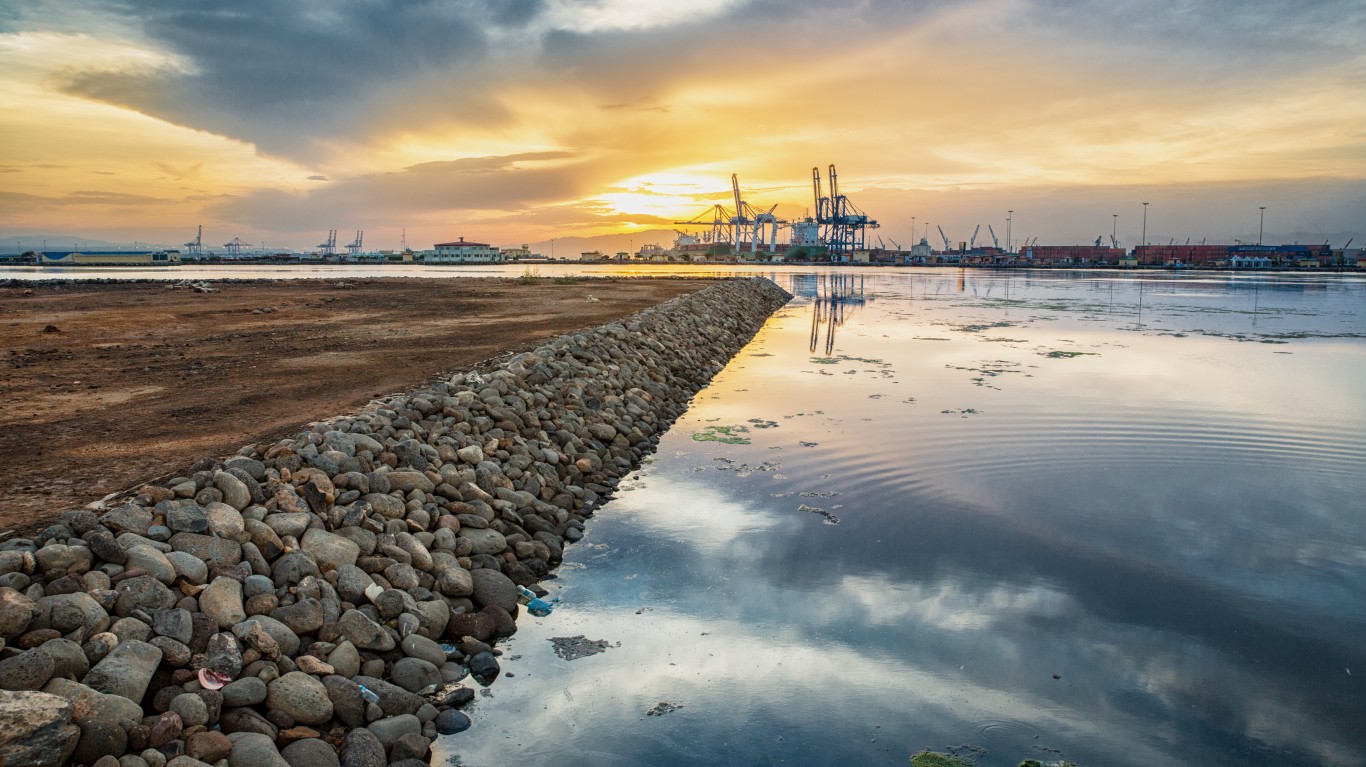
5. Djibouti
> Pop. exposed to unsafe air pollution levels: 100.0%
> Area with gov. protection: 1.2%
> GDP per capita: $2,705
Djibouti is a barren country of nearly 90% desert, and the country’s government has fallen short on land-use planning and water treatment and management. Djibouti is also particularly susceptible to the effects of global warming and needs to build up coastal protections, shore up landfill walls, and install drainage systems for water, among other precautionary measures.
Deforestation is depleting the country’s already limited wooded areas. Currently, only 1.2% of the country’s territory is protected as national parks, wildlife reserves and sanctuaries, or areas managed for sustainable use. Additionally, the presence of harmful fine particle pollution has climbed by 54.3% between 1990 and 2016 and everyone who lives in Djibouti is exposed to harmful levels of air pollution.

4. Eritrea
> Pop. exposed to unsafe air pollution levels: 100.0%
> Area with gov. protection: 3.0%
> GDP per capita: $1,510
Though Eritrea has signed the Paris Agreement on climate change and issued a proclamation in 2017 for environmental protection and restoration, it continues to be among the nations with the fewest environmental protections. Only about 11% of the population have access to basic sanitation services. Droughts, floods, and irregular rain patterns have led to soil erosion, desertification, and land degradation.
[in-text-ad]

3. Lesotho
> Pop. exposed to unsafe air pollution levels: 100.0%
> Area with gov. protection: 0.3%
> GDP per capita: $2,665
Lesotho, in southeastern Africa, has almost no protected marine or terrestrial areas. Destruction of groundcovers and an abundance of surface water have led to soil exhaustion and erosion. The Lesotho Highlands Water Project uses dams and tunnels to channel some of the excess surface water to South Africa and generate hydroelectricity. A second phase of the project is expected to be completed in 2020.
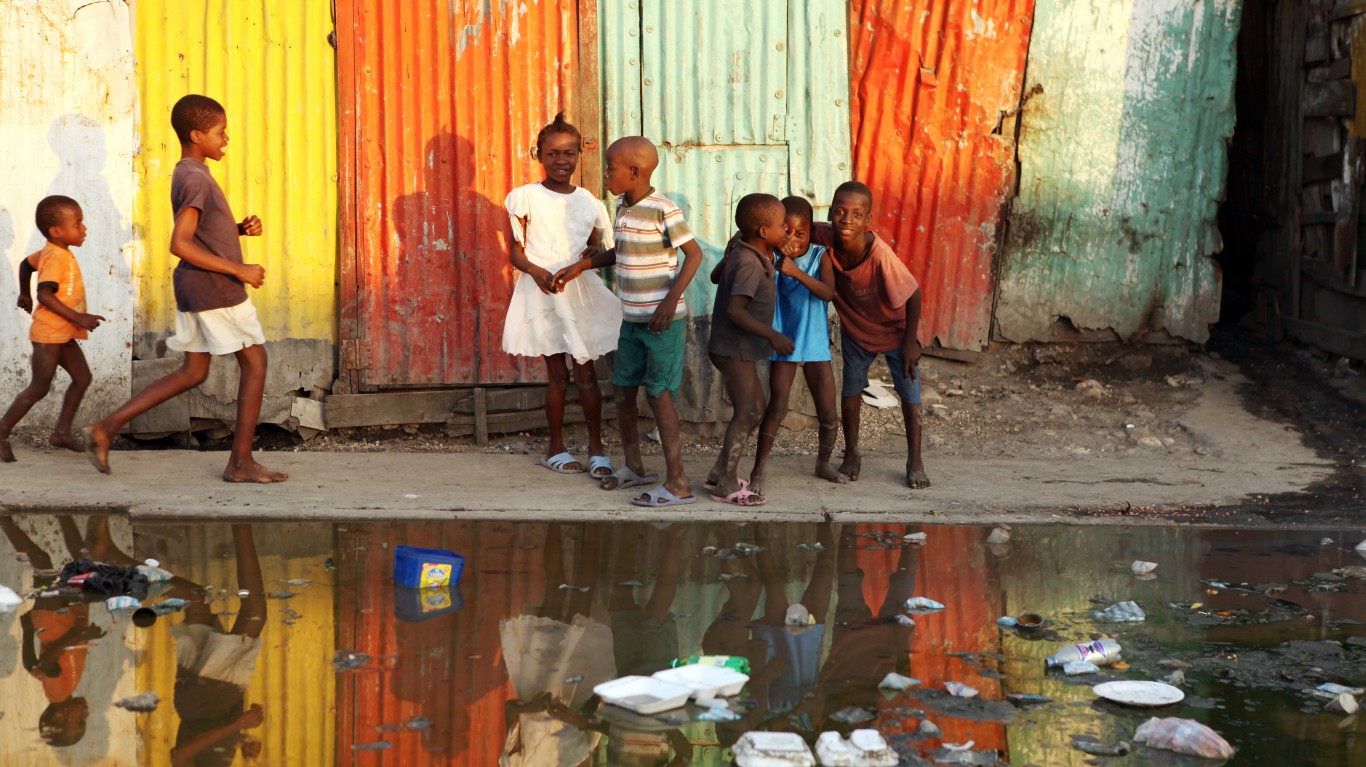
2. Haiti
> Pop. exposed to unsafe air pollution levels: 100.0%
> Area with gov. protection: 0.4%
> GDP per capita: $1,653
The Caribbean island nation of Haiti is the poorest country in the Western Hemisphere, with millions of people subsisting below the poverty line. It’s also prone to natural disasters, including hurricanes and earthquakes. Deforestation, soil erosion, sedimentation in coastal waters, water pollution, and poor waste management are among the environmental challenges. A variety of government agencies and NGOs are assisting Haiti in developing more sustainable agricultural and business practices.
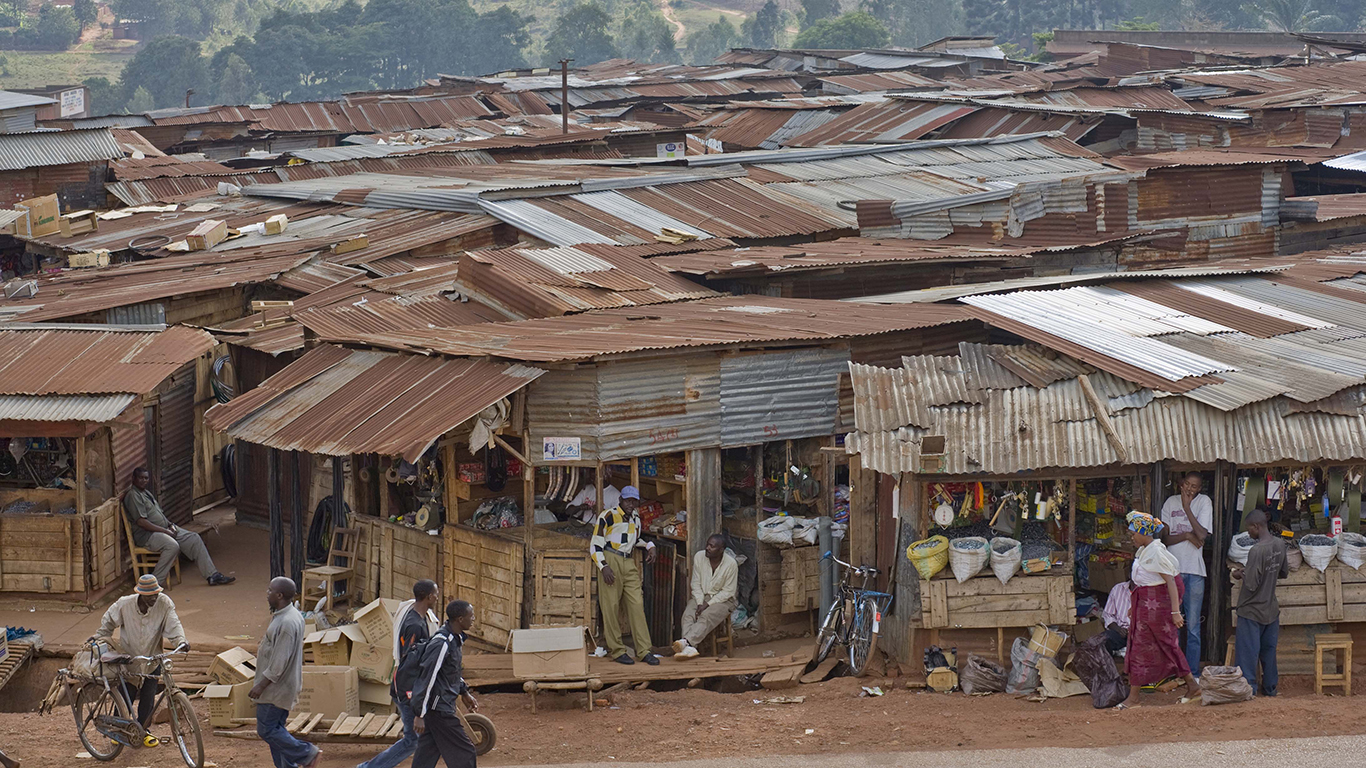
1. Burundi
> Pop. exposed to unsafe air pollution levels: 100.0%
> Area with gov. protection: 7.6%
> GDP per capita: $668
Carbon emissions from fossil fuel and cement production rose in Burundi by a whopping 183.2% between 2007 and 2017. Deforestation, disappearance of wetlands, and water pollution are among the pressing environmental issues in the east-central Africa nation. With a tiny per capita GDP of $668, Burundi is among the poorest nations in the world, with almost 75% of the population living below the poverty line, and there is little awareness of environmental protection practices. Burundi has signed the Paris Agreement to fight back against climate change, but the road to the country taking any environmental measures when it struggles with so many issues is bound to be challenging.
Methodology
To determine the most environmentally conscious countries, 24/7 Wall St. reviewed Yale University’s 2018 Environmental Performance Index (EPI). The EPI scores 180 countries on environmental health and ecosystem vitality. These two areas consist of several subfactors:
Environmental Health: air quality, water quality, heavy metals, PM2.5 extendance, sanitation, lead exposure, PM2.5 exposure, drinking water, household solid fuels.
Ecosystem Vitality: biodiversity, forests, fisheries, climate & energy, air pollution, water resources, marine protected areas, tree cover loss, fish stock status, CO2 emissions total, SO2 emissions, wastewater treatment, biome protection-national, species protection index, representativeness index, species habitat index, regional marine trophic, CO2 emissions power, NO emissions, methane emissions, N2O Emissions, black carbon emissions.
A country’s place on our list was also affected by the presence of environmentally friendly policies and programs enacted (for example having laws in place that enforce solid waste regulations and having readily available waste management information for the public). This comes from the World Bank’s “What a Waste Database,” which was last updated in September 2018.
We also reviewed supplementary measures related to EPI themes — such as health impacts, air quality, water and sanitation, water resources, agriculture, forests, fisheries, biodiversity and habitat, and climate and energy — from the World Bank for 2017 or the most recent period available. Data on GDP per capita also came from the World Bank and is in current international PPP dollars for 2017.
Choosing the right (or wrong) time to claim Social Security can dramatically change your retirement. So, before making one of the biggest decisions of your financial life, it’s a smart idea to get an extra set of eyes on your complete financial situation.
A financial advisor can help you decide the right Social Security option for you and your family. Finding a qualified financial advisor doesn’t have to be hard. SmartAsset’s free tool matches you with up to three financial advisors who serve your area, and you can interview your advisor matches at no cost to decide which one is right for you.
Click here to match with up to 3 financial pros who would be excited to help you optimize your Social Security outcomes.
Have questions about retirement or personal finance? Email us at [email protected]!
By emailing your questions to 24/7 Wall St., you agree to have them published anonymously on a673b.bigscoots-temp.com.
By submitting your story, you understand and agree that we may use your story, or versions of it, in all media and platforms, including via third parties.
Thank you for reading! Have some feedback for us?
Contact the 24/7 Wall St. editorial team.